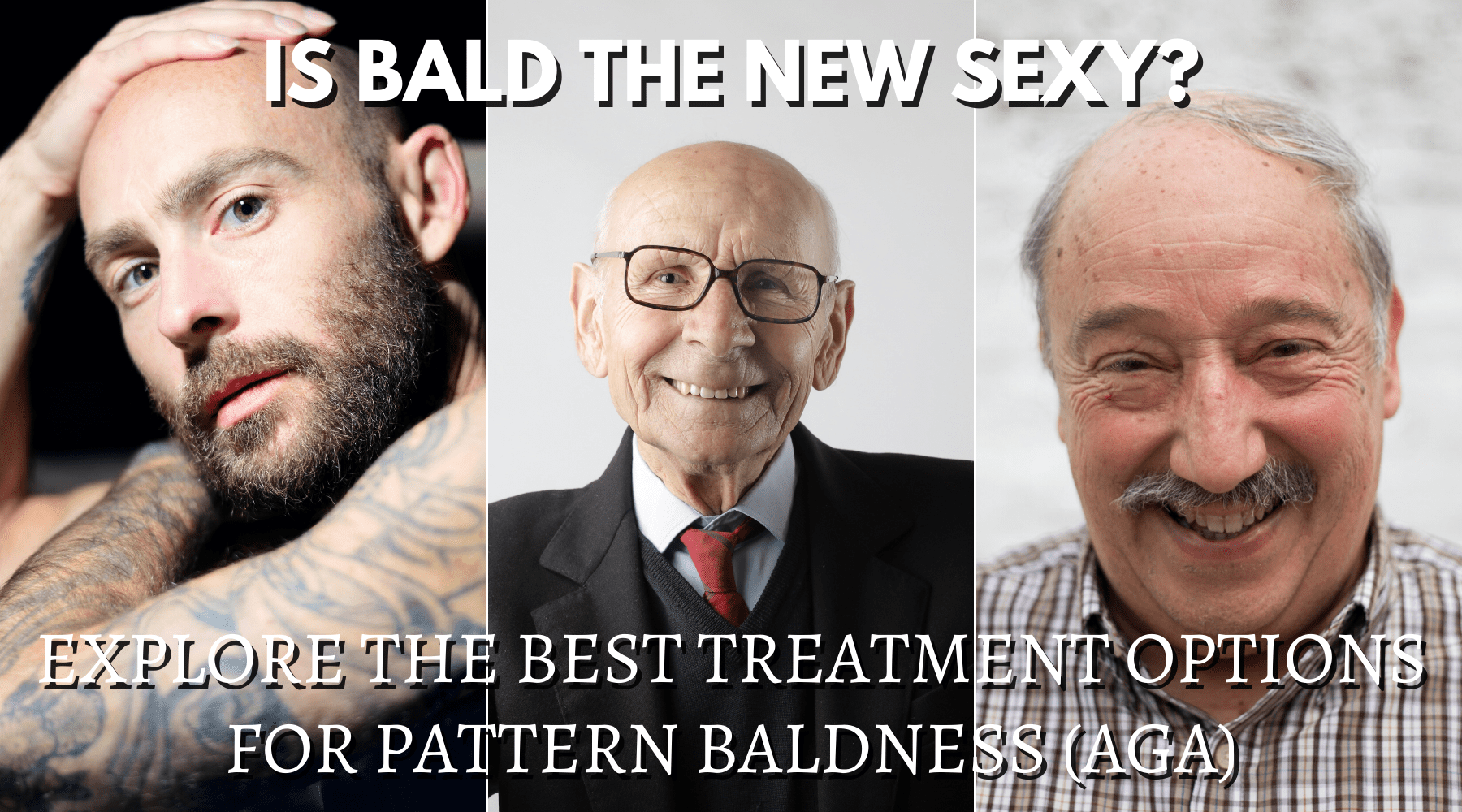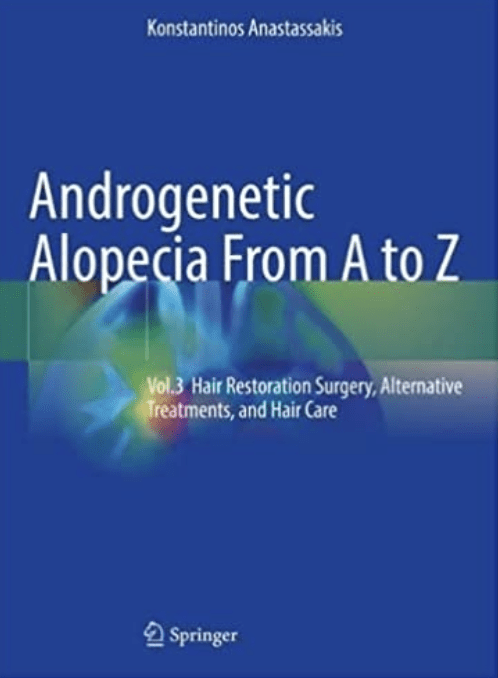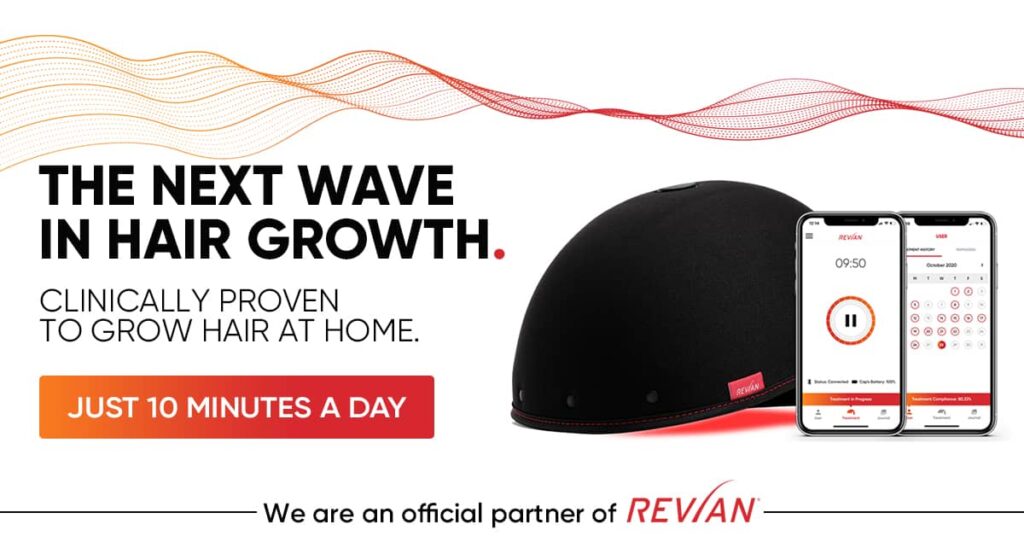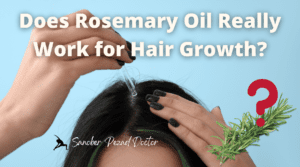What are the Best Treatment Options for Androgenetic Alopecia (Male & Female Pattern Hair loss)?

Androgenetic alopecia (AGA), also known as male or female pattern baldness, is the most common type of hair loss and affects at least 80% of men and half of women by age 70, with the incidence increasing with age.
As a practicing dermatologist and hair specialist with tonnes of experience when it comes to managing conditions of the hair, I am aware of how challenging it is to address this condition. There are a wide variety of treatment options to choose from which often involves a complex consideration of multiple factors and ethical decision‐making and I am also aware of how frustrating it is for the patient to continue with its treatment and to see visible results. [1, 2, 3]
In the previous article- Why Do We Lose Hair as we Age?- Everything you need to know about Male & Female Pattern Hair loss (Androgenetic Alopecia) we discussed in detail the causes of Androgenetic Alopecia aka Male /Female Pattern Hair loss along with the tests that you can perform yourself to identify this condition in a timely manner.
Remember, when you see the visible portions of your scalp, at least 50% of the scalp hair has already been lost.
This is the reason why I always stress early detection and correction of any condition, as correcting something that has already advanced is always very difficult.
The reason I wanted to address this issue at the onset, is that although a healthy scalp and hair are of prime importance, I have observed that the general public is not given the right knowledge and guidance about these issues. Nonetheless, I will try my best to decode and guide you on your journey toward treating Androgenetic Alopecia.
Treatment of Androgenetic Alopecia/ Pattern Hair Loss
I like dividing the treatment options for Androgenetic alopecia/ Pattern Hair loss into 3 types.
- Medical Management
- Surgical Management/Procedures
- The ‘HAPPY GO LUCKY’ Way
These 3 types cater to two primary areas of consideration :
- The NEED for Treatment
- The DESIRE for Treatment
If you are someone who desires a head full of healthy hair or have been told about the need for hair regrowth, you’ll enjoy learning about the various options that are available today.
Medical Treatment Options for Male/Female Pattern Baldness (Androgenetic alopecia)
The various topical and oral treatment options available today are primarily directed toward the treatment and reversal of hair follicle miniaturization. These include:
1. Topical Minoxidil (Available Over the Counter)
Topical Minoxidil is widely available at stores and online and is one of the only three FDA‐approved treatments for male and female pattern hair loss.
- What does the literature say? Topical minoxidil was approved specifically for Androgenetic Alopecia (AGA) in 1988 as a first‐line treatment for men with mild‐to‐moderate AGA. [6,7] The oral formulation was originally used in the 1960s as a vasodilator for the treatment of hypertension (high blood pressure). [8] Hypertrichosis i.e. excessive hair growth anywhere over the body was discovered as a side effect of chronic use of oral minoxidil, which prompted the development of a topical formulation for hair growth stimulation. [9] In clinical trials, minoxidil has been shown to reduce hair loss, stimulate hair growth, and strengthen existing strands of hair. While minoxidil can help, you’re unlikely to see full hair regrowth.
- How & When to use it? Minoxidil is readily available in both 2% and 5% foam and liquid solutions with varying efficacies. [10, 11] It should be applied to the areas of the scalp where hair thinning is present and gently massaged. I find the use of 5% Minoxidil once a day for women and twice a day for men very safe and efficacious. But remember, you need to apply it every single day!
- How long it takes to see results? In my experience, some respond to minoxidil better than others. If minoxidil works for you, it can take up to 6-12 months to see visible results. You will have to continue using it as long as you wish to retain hair over your head!
- Possible side effects: When using minoxidil, some men develop an irritated scalp. The newer formulation, which is a foam, seems to reduce this risk. Other possible side effects include an itchy scalp or headaches. also, make sure, it doesn’t dribble over your face (especially in women) or you might notice unwanted hair growth over your face as well!
- What happens if you stop using minoxidil? I cannot emphasize the importance of adherence to treatment when it comes to using minoxidil. You sure will see amazing results but you will lose its benefits as soon as you stop applying minoxidil. Also, because minoxidil helps you maintain your hair’s thickness, your hair may look and feel thinner once you stop using it. You’ll also gradually notice that you’re shedding more hair.
2. Finasteride & Dutasteride (prescription medications)
- What does the literature say? The more commonly used of the two, finasteride has been FDA-approved for the treatment of male pattern baldness since 1997. Both medications work by inhibiting 5‐alpha‐reductase, the enzyme responsible for blocking the conversion of testosterone to Dihydrotestosterone.
- How and When to use it? It is available in 1 mg and 5 mg tablets, of which the lower dose is indicated for male pattern baldness. It is not approved for use in women and is assigned to pregnancy category X due to the risk of causing ambiguous genitalia in a male fetus. Hence, it is recommended that you consult your dermatologist before embarking on your journey with these medications.
- How long it takes to see results? If finasteride works for you, you will start to see results in about 6-12 months.
- Possible side effects: There have been side effects reported with the use of these medications. These include loss of libido (desire to have sex), inability to get or keep an erection, swelling, and tenderness in their breasts, and depression. It’s been reported that sexual side effects can continue after a patient stops taking finasteride. Due to the seriousness of these side effects, it is best to discuss them with your dermatologist before they are prescribed to you.
- What happens if you stop taking finasteride? Just like minoxidil, you must continue taking the pill every day to maintain the results. The combination of topical minoxidil and oral finasteride works very well. Remember, once you stop taking this medication, hair loss will return.
3. Devices for Treating Male/ Female Pattern Hair loss
Several laser devices are now available to treat hair loss at home. The FDA has cleared some. So, if you see “FDA cleared” on the packaging or within the information booklet about the laser, this means the FDA recognizes the laser as a safe treatment.
But I want to bring one point to your notice… The requirements for getting FDA clearance are much less stringent than for getting FDA approved!
Nonetheless, men and women have seen improvement when these are used as an adjunct to other modalities of treatment.
There are a lot of products available in the market today for home use and there are many factors to consider before you make a choice (I’ll deal with this detail in a separate article.)
I am particularly fond of Revian’s RED Hair Growth System and the CapillusPro Mobile Laser Therapy Cap. They are simple for home use, requiring 10-20 minutes of use and I am hopeful this will serve as an asset given that so many of us work from home these days!
We are excited to partner with REVIAN RED, the first and only FDA-cleared, all LED hair loss treatment for men & women, clinically proven to grow more hair in less time.
Revian has graciously offered all my readers $550 OFF the retail price, use coupon code: DRDOCTOR to avail the discount.
Surgical Management of Male/ Female Pattern hair loss (Androgenetic Alopecia)
If waiting for the results of applying topical minoxidil and/or oral finasteride is not something you are ready for, then depending on the location and extent of your hair loss, you can opt for these procedures in consultation with your dermatologist.
1. Hair transplantation
This is one of the best semi-permanent solutions for covering your receding hairline or bald spot and the secret behind most of your on-screen idols continuing to maintain a head full of hair.
There are 2 types of procedures– Follicular Unit Transplantation (FUT) and Follicular Unit Extraction (FUE). Based on your choice of surgeon and his expertise, along with the extent of your hair loss, the type of procedure is determined. While they are slightly different methods in terms of the way your donor hair will be extracted, these transplants basically work by removing the hair follicles from the back of your head and then transplanting them to the areas where hair is thinning.
An important point that I want you to bear in mind, is that this procedure does NOT act on the physiological cause that is causing pattern hair loss/androgenetic alopecia in the first place. You may need to use topical minoxidil to maintain your results and perhaps even need a re-transplant in the future if you have had the procedure done at a younger age.
2. Platelet-rich plasma (PRP)
This is an in-office procedure that involves drawing your blood and then separating out the plasma that is rich and concentrated in platelets by a special method of centrifugation.
This platelet-rich plasma (PRP) is rich in growth factors that can stimulate the repair of blood vessels and promote wound healing and is hence an excellent adjunct to hair transplantation or medical forms of treatment.
A word of caution though- I know of so many who do not know the correct technique for preparing platelet-rich plasma. Some simply separate the serum from your blood and inject it in the name of PRP. So, make sure you get your treatment sessions from a Board- Certified Dermatologist who is an expert in the procedure. Otherwise, you are better off not getting the procedure done at all, instead of wasting your precious blood and hard-earned money.
Also, always remember that PRP is not a permanent solution either. You will need follow-up sessions but they will help maintain results in the long run.
The ‘HAPPY GO LUCKY’ Way for treating Male/ Female Pattern Hair loss
Going bald can be a big change and it is normal to have trouble accepting your changing appearance.
But you DON’T HAVE TO TREAT THIS TYPE OF HAIR LOSS if you don’t wish to.
Remember, all the treatment options that we discussed need to be maintained over a very long period of time… almost till the time you wish to benefit from the treatment results- i.e. hair growth! Most forms of treatment can help reduce further hair loss, and some regrow hair to some extent.
But I want to address a very important issue here.
This condition is more aesthetically distressing than actually causing any significant harm to the body. History is testimony cause even Vincent van Gogh′s famous painting ′On the threshold of eternity′ also known as ‘Old Man in Sorrow’ is thought to depict deep depression, partly attributed to a balding scalp. [12]
If you are someone who is unaffected by external appearances and can graciously accept the loss of scalp hair over time, not opting for any particular treatment will be just fine.
I’ll repeat what I said before, ‘You DON’T HAVE TO TREAT THIS TYPE OF HAIR LOSS.’
A very good option that is readily available these days is Hair Camouflage Techniques.
Wigs or hairpieces
Wigs can cover thinning hair, receding hairlines, and even complete baldness. They come in a variety of styles, colors, and textures. For a natural look, feel free to experiment and choose wig colors, styles, and textures that look similar to your original hair.
Weaves
Hair weaves are wigs that are sewn into your natural hair. For this, you must have enough hair to sew the weave into. The advantage of weaves is they always stay on, even during activities such as swimming, showering, and sleeping. The disadvantages are they must be sewn again whenever new hair growth occurs, and the sewing process can damage your natural hair.
But if the receding hairline and thinning of hair is not something you are ok with, I am here to assure you that there are plenty of options to reverse it, it just requires time, patience, and an earlier start toward correction.
Just FYI, a bald scalp looks just as sexy and appealing as a head full of hair. It ultimately boils down to your perception of beauty and desire.
The Verdict
I know treating androgenetic alopecia can seem overwhelming. As I mentioned before, it ultimately boils down to the
- The NEED for Treatment
- The DESIRE for Treatment
Certain patient populations are more prone to aging and thinning of their hair, particularly those who practice certain grooming procedures, whose hair is graying or fair colored, and who are inadvertently exposed to weathering factors. Most people do not realize that UV exposure has negative effects not only on the skin but on the hair as well, especially when it is devoid of melanin.
Also, what we discussed is just the tip of the iceberg. There are a lot of factors to be taken into account when it comes to treating patterned hair loss and regrowing hair. We’ll also discuss various non-pharmaceutical options available which are worth trying. I also want to stress the importance of diet, and lifestyle which play a very important role in hair growth.
As with every form of treatment, I have seen the best results when the treatment is individualized and tailored according to your body type. Every human being’s needs, requirements, and circumstances are different, and I’ll always be happy to guide you with any skin, hair, or health-related concern need that you may require. You can book a call here and check for availability.
There sure is a lot of information available online but there is very little guidance as to how to appropriately care for their hair and scalp. Healthy hair and a healthy scalp typically complement each other, so a healthy scalp is needed to give the appearance of healthy hair and vice versa. [4] I discuss the Do’s and Don’ts for Healthy hair in detail in the article- Important Hair Care Tips that you MUST KNOW- Healthy Hair Care Do’s and Don’ts
?A very good read to learn more about the details of treating androgenetic alopecia for my geek fellows is this book-
1. Androgenetic Alopecia From A to Z: Vol. 2 Drugs, Herbs, Nutrition, and Supplements


Sending lots of healthy and happy wishes your way. ?
P.S.- If you like what I share, consider Subscribing to stay connected & Up to Date with the latest Pearls of Wisdom. I do NOT spam. Promise! ?
Also, please leave a comment and share the article with your loved ones. Sharing is Caring!
Feel free to ask a question or leave a suggestion as well. I am always open to learning. ?
References
1. Giornale Italiano di Dermatologia e Venereologia 2014 February;149(1):15‐24. https://www.minervamedica.it/en/journals/dermatologia‐venereologia/article.php?cod=R23Y2014N01A0015.
2. Kelly Y, Blanco A, Tosti A. Androgenetic alopecia: an update of treatment options. Drugs. 2016;76(14):1349‐1364. https://pubmed.ncbi.nlm.nih.gov/27554257
3. York K, Meah N, Bhoyrul B, Sinclair R. A review of the treatment of male pattern hair loss. Expert Opin Pharmacother. 2020;21(5):603‐612. https://pubmed.ncbi.nlm.nih.gov/32066284
4. What Ages Hair? https://www.ncbi.nlm.nih.gov/pmc/articles/PMC5419032/
5. Treatment options for androgenetic alopecia: Efficacy, side effects, compliance, financial considerations, and ethics https://www.ncbi.nlm.nih.gov/pmc/articles/PMC9298335/
6. Cranwell W, Sinclair R. Male androgenetic alopecia. In: Feingold KR, Anawalt B, Boyce A, et al, eds. Endotext. MDText.com, Inc.; 2016.
7. Rossi A, Anzalone A, Fortuna MC, et al. Multi‐therapies in androgenetic alopecia: review and clinical experiences. Dermatol Ther. 2016;29(6):424‐432. https://pubmed.ncbi.nlm.nih.gov/27424565/
8. Kosman ME. Evaluation of a new antihypertensive agent. Minoxidil. JAMA. 1980;244(1):73‐75. https://pubmed.ncbi.nlm.nih.gov/6103968/
9. Panchaprateep R, Lueangarun S. Efficacy and safety of oral minoxidil 5 mg once daily in the treatment of male patients with androgenetic alopecia: an open‐label and global photographic assessment. Dermatol Ther. 2020;10(6):1345‐1357. [PMC free article] [PubMed] [Google Scholar]
10. Blume‐Peytavi U, Hillmann K, Dietz E, Canfield D, Garcia BN. A randomized, single‐blind trial of 5% minoxidil foam once daily versus 2% minoxidil solution twice daily in the treatment of androgenetic alopecia in women. J Am Acad Dermatol. 2011;65(6):1126‐1134.e2. [PubMed] [Google Scholar]
11. Price VH, Menefee E, Strauss PC. Changes in hair weight and hair count in men with androgenetic alopecia, after application of 5% and 2% topical minoxidil, placebo, or no treatment. J Am Acad Dermatol. 1999;41(5 Pt 1):717‐721. [PubMed] [Google Scholar]
12. Aronson JK, Ramachandran M. The diagnosis of art: Van Gogh and male pattern baldness. J R Soc Med 2009;102:32-3. https://scholar.google.com/scholar








Comments
I like that you shared many options! This can be so helpful for the right person, thanks for sharing!
Thank you, Hannah!